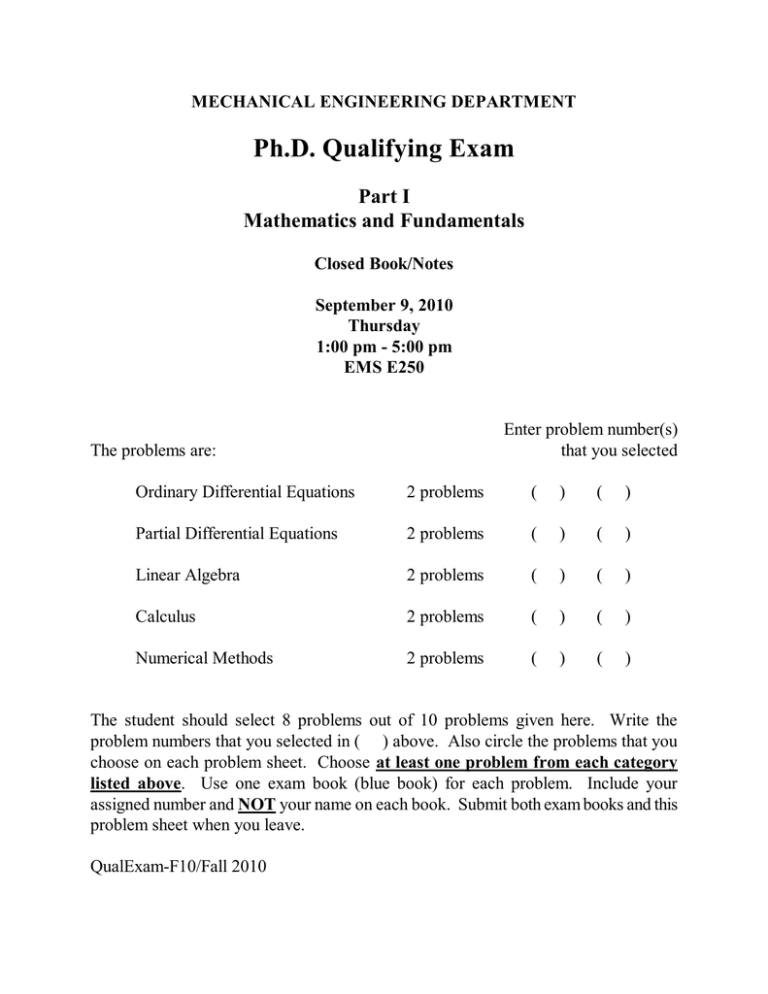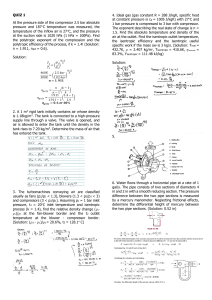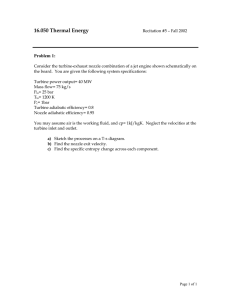MECHANICAL ENGINEERING DEPARTMENT
advertisement

MECHANICAL ENGINEERING DEPARTMENT Ph.D. Qualifying Exam Part I Mathematics and Fundamentals Closed Book/Notes September 9, 2010 Thursday 1:00 pm - 5:00 pm EMS E250 Enter problem number(s) that you selected The problems are: Ordinary Differential Equations 2 problems ( ) ( ) Partial Differential Equations 2 problems ( ) ( ) Linear Algebra 2 problems ( ) ( ) Calculus 2 problems ( ) ( ) Numerical Methods 2 problems ( ) ( ) The student should select 8 problems out of 10 problems given here. Write the problem numbers that you selected in ( ) above. Also circle the problems that you choose on each problem sheet. Choose at least one problem from each category listed above. Use one exam book (blue book) for each problem. Include your assigned number and NOT your name on each book. Submit both exam books and this problem sheet when you leave. QualExam-F10/Fall 2010 Ordinary Differential Equation #1 Solve the differential equation below for y (x) y"6 y '9 y e 3 x x5 Ordinary Differential Equation #2 The position from equilibrium, y, at a time, t, in a damped spring-mass system is described by the equation d2y dt 2 5 dy y0 dt The momentum for this system is given by p = dy/dt For the initial conditions of y(0) = 2, p(0) = -2, find (a) the equation describing the position, y, as a function of time, (b) the equation describing the momentum, p, as a function of time, and (c) the total energy of the system at t = 1.5. Partial Differential Equation #1 Solve 2Z x 2 2Z y 2 0 where 0 < x < and 0<y< with the boundary conditions: Z (x,0) = 4 sin2 x , 0 < x < Z (x, = 0, 0 < x < Z (0,y) = cos2y, 0 < y < Z (,y) = 0, 0 < y < Partial Differential Equation #2 The differential equation to describe the transient heat conduction is given as: 0 x 1 u 2u 2 t x 0 x 1 with the initial conditions of u linearly varying from 0 to 1 from x=0 to x=1. Solve the above equation for the boundary condition: B.C.: u0 and u 0 x at x 0 at x 1 Data: Thermal diffusivity: =constant=1 Linear Algebra #1 Find the eigenvalues and eigenvectors of the following matrix: 1 2 3 A 2 1 3 3 3 6 Linear Algebra #2 1 2 2 Given the matrix A 2 3 6, find the inverse A1. 1 1 7 Show all your work. Calculus #1 Evaluate the volume, V generated when the area bounded by the curve y ax 2 , the x axis and the line y 2b is revolved about the y axis. Calculus #2 1 x lim Please find: x1 x 1 ln x Numerical Methods #1 Using the second-order terms of the Taylor series expansion and the forward-time and centered-space differencing, show that the advection equation f 2 f 2 t x can be formulated as: fi n 1 fi n 1 f n 2 fi n fi n1 i 1 2t x 2 where α=constant What is the order of the accuracy? Using von Neumann stability analysis, determine the stability condition. Numerical Methods #2 The following is a set of two simultaneous nonlinear equations with two unknowns: x1 x1 x 2 10 2 x 2 3x1 x 2 57 2 Use the multiple-equation Newton-Paphson method to determine the roots of the above equations. Initiate the computation with guesses of x1 = 1.5 and x2 = 3.5. MECHANICAL ENGINEERING DEPARTMENT Ph.D. Qualifying Exam Part II Area of Concentration Thermal Science Stem Open Book/Notes September 10, 2010 Friday 1:00 pm – 5:00 pm EMS E250 Enter problem number(s) that you selected The problems are: Fluid Mechanics 3 problems ( ) ( ) ( ) Thermodynamics 3 problems ( ) ( ) ( ) Heat Transfer 3 problems ( ) ( ) ( ) The student should select 6 problems out of 9 problems given here. Write the problem numbers that you selected in ( ) above. Also circle the problems that you choose on each problem sheet. Choose at least one problem from each category listed above. Use one exam book (blue book) for each problem. Include your assigned number and NOT your name on each book. Submit both exam books and this problem sheet when you leave. QualExam-F10/Fall 2010 Fluid Mechanics #1 Consider long surface waves that propagate in a channel with a constant crosssection. The frequency is high enough, so that (v/)1/2 is small comparing with the width of the channel and its depth. Find the damping coefficient for he waves. Given: the size of the channel (a and h) and v/. Hint: Use the expression for average energy dissipation E the energy dependence on time E=E0exp(-2t) surface h liquid a 1 2 2 V df and 2 0 Fluid Mechanics #2 A horizontal flow with an inlet diameter of 1m is divided and has equal flow rates from each outlet. The outlets have diameter of 0.5 m. The inlet pressure is 200 kPa and the inlet flow rate is 5 m3/s. (a) Calculate the centerline pressure at the outlets assuming no friction losses. (b) Calculate the reaction forces on the divided flow that must be absorbed by a support system (c) Calculate the reaction forces on the divided flow if the friction loss between the inlet and either outlet is give by h= 1.6V2/2g, where V is the inlet velocity. Fluid Mechanics #3 A long cylinder in an infinite fluid with a constant density, , and constant viscosity, . Let the radius of the cylinder be R and the angular velocity of the cylinder be . Find: (a) (b) The velocity distribution of the infinite fluid The torque per unit length of the cylinder. Thermodynamics #1 Liquid water fills a tank with a volume of 0.002 m3. The water is initially at 40°C, with a pressure of 100 kPa. A pressure-relief valve is fitted onto the tank, such that saturated water vapor can escape from the tank to maintain a pressure of 100 kPa inside the tank. 1250 kJ of heat is added to the water. Determine how much water remains in the tank after the heating process is complete. Thermodynamics #2 Air enters the compressor of an ideal air-standard Brayton cycle at 1.01bar, 310K. The compressor pressure ratio is 12 and the temperature at the turbine exit is 770K. The velocity at the inlet of the compressor is 10m/s and the cross sectional area of compressor inlet is 0.5m2. Determine: (a) The mass flow rate in kg/s. (b) The net power developed in kW. (c) The thermal efficiency (d) The back work ratio (compressor work/turbine work). Use “Air-standard Analysis”, which means the specific heats are treated as a variable. [Hint] The cycle is a steady state with negligible kinetic and potential energy changes across each component. Thermodynamics #3 Superheated steam at 100 bar and 520 ◦C leaves the steam generator of a vapor power plant and enters a turbine with an isentropic efficiency of 90%. The pressure of the turbine at the exit is 0.08 bar. Saturated liquid leaves the condenser at 0.08 bar. The isentropic efficiency of the pump is 88%. Compressed liquid leaves the pump at 100 bar. The mass flow rate is 106 kg/hr. a) Draw a T-S diagram. Be sure to label clearly states 1, 2, 2s, 3, 4, and 4s. b) Using the isentropic efficiency of the turbine, find the specific enthalpy at state 2. c) Using the isentropic efficiency of the pump, find the specific enthalpy at state 4. d) The net power output, in MW. Heat Transfer #1 In a double pipe heat exchanger, oil (Cp=1.9 kJ/kg·K) at a flow rate of 5 kg/min is cooled from 120 °C to 80 °C by water which enters at 20 °C and exits at 50 °C. If the overall heat transfer coefficient is 160 W/m2·°C, calculate the required heat exchanger area for a). Parallel flow b). Counterflow Heat Transfer #3 An electronic device, for example a power transistor mounted on a finned heat sink can be modeled as a spatially isothermal object with internal heat generation and an external convection resistance. (a) Consider such a system mass M , specific heat capacity c, and surface area As , which is initially in equilibrium with the environment at T . The electronic device is suddenly energized so that a constant heat generation E g W occurs. Show that the temperature response of the device is: t exp( ) i RC Where T T () and T () is the steady state temperature; i Ti T (); R is thermal resistance and C is thermal capacitance. (b) An electronic device which generates 60W of heat, is mounted on an aluminum sink weighing 0.25 kg and attains a temperature of 100 C in ambient air at 20 C under steady state conditions. If the device is initially at ambient temperature what will be its temperature 10 minutes after power is switched on? MECHANICAL ENGINEERING DEPARTMENT Ph.D. Qualifying Exam Part II Area of Concentration Machine Design Stem Open Book/Notes September 10, 2010 Friday 1:00 pm - 5:00 pm EMS E250 Enter problem number(s) that you selected The problems are: Machine Design 3 problems ( ) ( ) ( ) Kinematics & Dynamics 3 problems ( ) ( ) ( ) Controls & Vibration 3 problems ( ) ( ) ( ) The student should select 6 problems out of 9 problems given here. Write the problem numbers that you selected in ( ) above. Also circle the problems that you choose on each problem sheet. Choose at least one problem from each category listed above. Use one exam book (blue book) for each problem. Include your student ID number and NOT your name on each book. Submit both exam books and this problem sheet when you leave. QualExam-F10/Fall 2010 Machine Design #2 An Acme-threaded power screw with a crest diameter of 1.125 in. and single thread is used to raise a load of 25,000 lb. The screw has 5 turns per inch. The collar mean diameter is 1.5 in. The coefficient of friction is 0.12 for both the thread and the collar. Determine the following: (a) Pitch diameter of the screw. (b) Screw torque required to raise the load. Controls & Vibration #2 A unity feedback system has the forward loop being KG( s) K 10( s 1) ( s 2)( s 4) 1) Please sketch the Nyquist plot for this system with K = 1 assess the stability of the closed loop system for K = 1 2) Determine the range of K for securing the closed-loop system stability using the Nyquist stability criterion. Controls & Vibration #3 The block diagram of the simplified control of the Yaw of the Lockheed Y-22 experimental fighter jet is shown below: Where (t ) is the desired yaw angle and (t ) is the actual angle. The feedback transfer function is that of a low pass filter that eliminates any high frequency noise. a) Sketch the Root Locus as the gain K is varied from 0 to (Apply all 9 rules) b) Find the gain K where the system is critically damped. c) Find the gain K where the system is marginally stable. What is the frequency of oscillation? d) Find the gain where the system is underdamped. e) Find the gain where the system is overdamped. Show all of your work.


